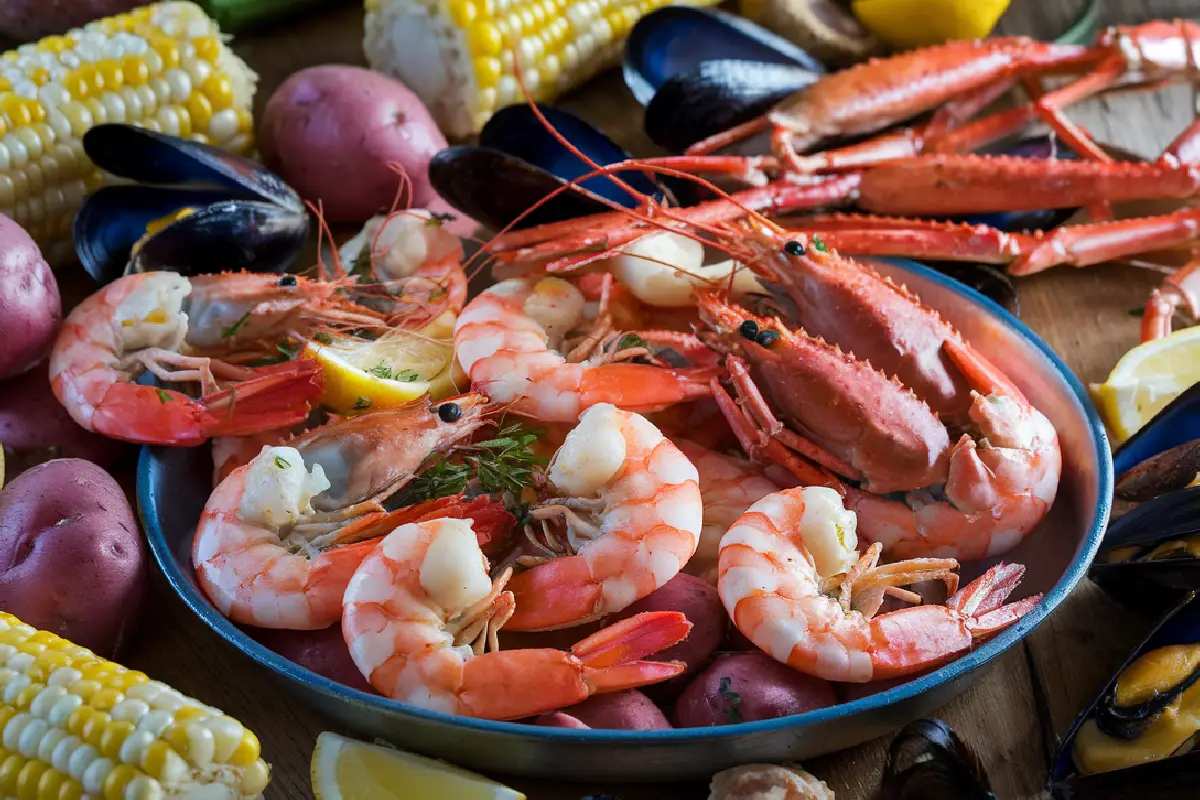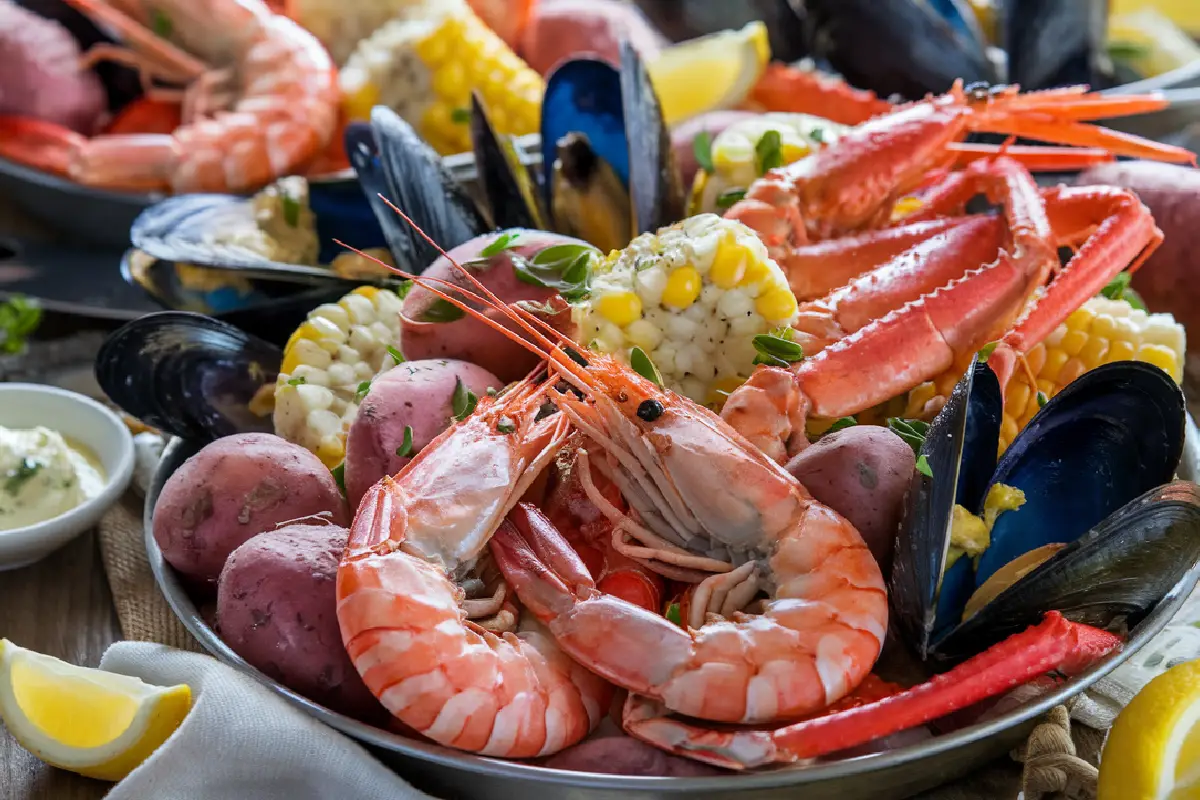Introduction to The Ingredients In a Seafood Boil
A seafood boil is a delightful, communal meal that brings together a variety of fresh seafood, vegetables, and proteins, all cooked together in a highly seasoned broth. This dish is perfect for social gatherings, where everyone can dig into a hearty mix of seafood, sausage, and veggies spread across a table. Whether you are a seasoned cook or trying it for the first time, understanding the essential ingredients of a seafood boil will help you recreate this flavorful dish at home.
Primary Ingredients in a Seafood Boil
The main appeal of a seafood boil is the diversity and freshness of its ingredients. Here’s a detailed look at what you can include in your seafood boil:
-
Seafood Choices:
- Shrimp: A staple in most seafood boils, shrimp brings a sweet, briny flavor. It’s best to use large shrimp with shells on to enhance the taste and protect them during cooking.
- Crab: Options include king crab legs, snow crab, and blue crab. Each type of crab brings its unique flavor and texture to the boil, making it a versatile choice.
- Lobster Tails: These add a luxurious touch with their tender and slightly sweet meat. Lobster tails cook quickly, so they are usually added towards the end.
- Mussels and Clams: Mussels and clams are great additions that soak up the seasoned broth, adding their unique oceanic flavor to the boil.
-
Proteins:
- Andouille Sausage: This spicy, smoked sausage adds a rich, savory flavor that complements the seafood. Its bold taste is a key ingredient that ties the entire boil together.
- Smoked Sausage: A milder alternative to andouille, smoked sausage still provides a savory element that balances the spiciness of the boil.
-
Vegetables:
- Corn on the Cob: Corn provides a sweet contrast to the savory and spicy elements of the boil. Cut into sections, it absorbs the flavors of the broth beautifully.
- Red Potatoes: Baby potatoes are preferred because they hold up well during boiling and soak up the delicious seasoned broth.
-
Additional Ingredients:
- Boiled Eggs: A traditional Southern addition, boiled eggs add an extra layer of texture and protein to the boil, making it more filling and unique.
Seasonings and Flavors
Seasonings are the heart of any seafood boil. They transform the simple ingredients into a bold and flavorful feast. Here’s what you need:
-
Seasoning Mixes:
- Old Bay Seasoning: A classic choice that includes celery salt, black pepper, and paprika. It’s the go-to seasoning for seafood boils, adding a balanced mix of savory and spicy flavors. For more on this essential ingredient, visit the Old Bay Seasoning guide.
- Cajun Seasoning: This mix of garlic powder, onion powder, cayenne pepper, and paprika brings a spicy kick, making the boil extra flavorful and aromatic.
- Creole Seasoning: Similar to Cajun seasoning but with the addition of herbs like thyme and oregano, giving the boil a slightly different flavor profile that’s herbaceous and bold.
-
Aromatics:
- Garlic: Fresh garlic cloves add a robust, savory element to the boil.
- Onions: Yellow or sweet onions provide a subtle sweetness that balances the heat from the spices.
- Lemons and Limes: Slices of citrus are essential, adding brightness and acidity that cuts through the richness of the seafood and sausage.
-
Spices and Herbs:
- Bay Leaves: These add an earthy, slightly minty flavor that enhances the overall taste of the broth.
- Paprika, Cayenne Pepper, Chili Powder: These spices add varying levels of heat and smokiness, allowing you to adjust the spiciness according to your preference.
-
Flavor Enhancers:
- Beer: Adds a malty, slightly bitter flavor that complements the spices and enhances the broth.
- Apple Cider Vinegar: Enhances the tanginess of the boil and helps to tenderize the seafood.
Adding the right combination of seasonings will elevate your seafood boil to new heights. For more tips on perfecting your seasoning, check out this guide on making a Seafood Boil Sauce Recipe.
Liquid Base
The liquid base of your seafood boil is as important as the seasonings. It’s what infuses all the ingredients with flavor.
- Water or Broth: Most boils start with water, but using a seafood or vegetable broth can add extra depth of flavor.
- Beer or Wine: Adding beer or white wine to the liquid base can enhance the boil’s overall taste, making it richer and more aromatic.
- Lemon Juice: Freshly squeezed lemon juice adds a citrusy brightness that lightens the dish and balances the other flavors.
Butter Sauces and Dipping Sauces
No seafood boil is complete without a rich, buttery dipping sauce. Here are a couple of popular options:
-
Garlic Butter Sauce:
- This sauce is made by melting butter and mixing it with minced garlic, parsley, lemon juice, and a bit of seasoning. It’s perfect for drizzling over the seafood or dipping the pieces as you eat.
-
Spicy Cajun Sauce:
- A bolder option that includes hot sauce, extra cayenne pepper, and minced garlic. This sauce adds another layer of heat and flavor to your seafood.
These sauces enhance the dining experience, making each bite more indulgent and flavorful.
Cooking Equipment Needed
To make a successful seafood boil, you’ll need some essential tools:
- Large Pot or Seafood Steamer: Choose a pot that’s big enough to hold all the ingredients comfortably. If you’re making a large batch, consider using an outdoor propane burner to accommodate a bigger pot.
- Strainer Basket: This tool helps you lift the cooked ingredients out of the pot without making a mess, ensuring that all the seafood and veggies are perfectly drained.
- Outdoor Burner: While not essential, an outdoor burner is ideal for cooking large boils, especially when you’re hosting a crowd. It provides even heat and plenty of space for a bigger pot.
Step-by-Step Guide to Making a Seafood Boil
-
Prepare the Ingredients:
- Start by cleaning your seafood thoroughly. Peel the shrimp if desired, cut the sausage into bite-sized pieces, and chop the corn and potatoes.
-
Season the Water:
- Fill your pot with water or broth, and add your seasoning mix, garlic, onions, and other aromatics. Bring it to a boil.
-
Cooking Sequence:
- Begin by adding potatoes, as they take the longest to cook. Once they are nearly tender, add the sausage and corn. Finish by adding the seafood in stages: lobster tails first, followed by crab legs, mussels, and shrimp. This sequence ensures that each component is cooked perfectly.
-
Serving:
- Once everything is cooked, drain the liquid using the strainer basket and spread the ingredients out on a large table covered with newspaper or a big platter. Serve with dipping sauces, lemon wedges, and plenty of napkins.
Popular Variations of Seafood Boils


Seafood boils vary widely by region, each bringing its unique twist. Here are a few popular variations:
-
Low Country Boil:
- Originating from the Southeastern U.S., this boil typically includes shrimp, sausage, corn, and potatoes. It uses a milder seasoning blend, often less spicy than other boils.
-
New England Seafood Boil:
- This version features clams, lobster, and mussels, with a focus on butter and herbs rather than spicy seasonings. It’s a more delicate and fragrant boil.
-
Asian-Inspired Seafood Boil:
- This twist incorporates ingredients like soy sauce, ginger, and garlic, offering a unique flavor profile that blends traditional seafood boil spices with Asian-inspired aromatics.
These variations show how versatile seafood boils can be, allowing you to adapt the dish to your taste preferences or regional traditions.
Tips for Customizing Your Seafood Boil
- Adjust the spice level by adding more or less cayenne pepper, hot sauce, or chili powder based on your heat preference.
- Add extra ingredients like mushrooms, bell peppers, or even artichokes for a twist on the classic boil.
- Consider using different types of seafood, such as scallops or crawfish, to diversify the flavors and textures.
Health Considerations and Nutritional Value
Seafood boils are not just delicious; they can also be nutritious. Here’s what you should know:
- Seafood is an excellent source of protein, omega-3 fatty acids, vitamins, and minerals. It’s generally low in saturated fats, making it a heart-healthy choice.
- Vegetables like corn and potatoes add essential nutrients, including fiber, vitamins C and B6, and potassium.
- Be mindful of potential allergens, especially shellfish, and make substitutions as needed for guests with allergies. Using alternative proteins like chicken sausage can help maintain the boil’s appeal while accommodating dietary restrictions.
FAQs
-
What type of seafood is best for a boil?
- Shrimp, crab legs, mussels, and clams are commonly used. So you can also try adding crawfish or scallops for extra variety.
-
Can I make a seafood boil in the oven?
- Yes, you can bake the ingredients in a large roasting pan with some broth and cover them with foil. This method still infuses the seafood and veggies with great flavor.
-
How do I store and reheat leftovers?
- Store leftovers in an airtight container in the refrigerator for up to 3 days. Reheat gently in a skillet with a bit of water or butter to prevent drying out.
-
What’s the best way to serve a seafood boil?
- Spread the cooked ingredients on a large table covered with newspaper or a platter, and serve with dipping sauces and plenty of napkins.
-
Can I make a seafood boil without seafood?
- Absolutely! Substitute seafood with more vegetables and sausage. You can also use tofu or tempeh for a vegetarian version.
Conclusion
A seafood boil is an experience that brings people together around a table filled with fresh ingredients, bold flavors, and communal enjoyment. With the right mix of seafood, spices, and creativity, you can create a memorable and delicious feast that everyone will love. Don’t be afraid to experiment with different ingredients and seasonings to make the boil your own. Now, grab your pot, gather your friends, and get ready to enjoy the rich and vibrant flavors of a seafood boil!
